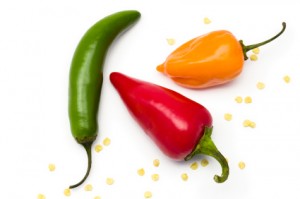 Peppers and chiles can really spice up your everyday foods. But if you don’t know one type of chili from another or very little about the heat they’re packing, you could end up with more fire than you bargained for! Plus, wouldn’t it be a shame to ruin a perfectly good dish because it was too spicy? You may want to learn a bit more about the many varieties of chili peppers - because they bring more to the table than just heat.
Peppers and chiles can really spice up your everyday foods. But if you don’t know one type of chili from another or very little about the heat they’re packing, you could end up with more fire than you bargained for! Plus, wouldn’t it be a shame to ruin a perfectly good dish because it was too spicy? You may want to learn a bit more about the many varieties of chili peppers - because they bring more to the table than just heat.
Health Benefits
Chiles are loaded with antioxidants – plant chemicals that travel throughout the body to help neutralize free radicals which can contribute to cancer and heart disease. Antioxidants are found in a variety of plants, especially ones that are brightly colored. The bright red, orange, yellow, and green hues of chili peppers are a sure sign they contain lots of health-promoting antioxidants. Chiles also help fight inflammation, reduce blood cholesterol, and blood clotting. If you can stand the heat – get some chiles in your kitchen!
If you’ve always been intrigued by the vibrant colors and unique shapes of chili peppers you’re not alone. But apart from looking at them, I’ve rarely used them in my cooking. Most recipes call for small amounts of chiles, usually a teaspoon or less, so I would just leave them out. This summer, I’m feeling a little adventurous and have set out to explore the flavor and health benefits locked inside peppers and chiles.
Where the Heat Comes From
Chili peppers contain capsaicin, the substance responsible for the characteristic “bite” of peppers, ranging from mild to firehouse hot. Generally, the more capsaicin a pepper has, the hotter it is. Capsaicin is most concentrated in the inner pith and seeds. To reduce the heat, cut away the inside of the pod – for maximum heat, leave it in. Just remember to wear gloves when handling peppers and chillies to prevent skin and eye irritation.
How Hot is Hot?
Believe it or not, there is a standard scale by which to measure the heat of chili peppers. It’s called the Scoville Chili Heat Scale. The rating scale, developed by Wilbur L. Scoville, indicates the amount of capsaicin in different varieties of chili peppers and sauces. The scale starts with “0″ and expands into the millions. The bottom of the scale represents the mildest chiles, while chiles at the top end of the scale may require a call to your local fire department.
6 Chiles That Are Good You
Here’s the scoop on six different kinds of chili peppers I picked up last weekend at the Wake Forest farmer’s market.
| Chili pepper | Scoville Heat Units | Heat |
| Pure capsaicin | 16,000,000 | FIRE! |
| Cayenne Pepper | 30,000 - 50,000 | Medium to very hot |
| Santa Fe Pepper | 400 - 700 | Medium |
| Jalapeno Pepper | 2,500 – 5,000 | Medium to hot |
| Poblano Peppers | 1,000 – 2,000 | Mild to medium |
| Banana Peppers | 100 - 900 | Medium |
| Anaheim Peppers | 500 – 2,500 | Mild to hot |
Sources: GourmetWorld.com, ChiliPlants.com, Gourmet Sleuth
A better tomorrow starts with what you eat today!
Want to eat more local food? Trying to escape food additives and preservatives? Tonya Peele is your go-to person for questions about natural foods and everyday health. Her new book, “Quick Wins for Healthy Eating”, breaks it down for you, making it simpler than ever to eat better and have fun in the kitchen. Go to www.tonyapeele.com to download a sample chapter of her book and sign up for her natural food newsletter.











